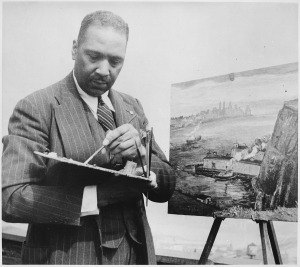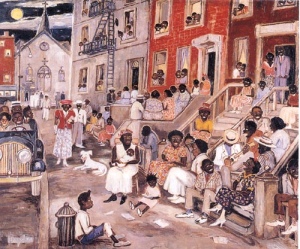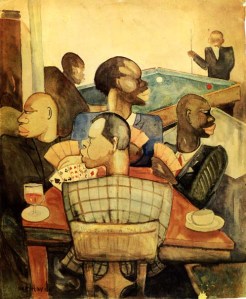
Palmer C. Hayden was an African American artist who was a self-trained artist from Virginia. The influences for his art came from the environment around him, specifically the time he spent in Paris. In France, his work tried to capture the elements of the Parisian lifestyle; much of his work after Paris focused on the African American experience. He tried to capture rural life and urban backgrounds in New York City/Harlem. He continued to make contributions to the art community until his death in 1973.
Palmer Hayden first gained recognition for his artwork by being awarded first prize from the Harmon Foundation. Before this award in 1927 he worked as a janitor and was an army veteran. This decision had a great impact because his lack of formal training and career as a janitor pointed out the restricted opportunities for African Americans during this period while also highlighting the Harmon Foundation as a group that advocates for the poor and minorities. This award jump started Hayden’s career as an artist. Art historians give credit to Hayden for his paintings that portray African American folktales. However, he has been accused of catering to stereotypical imagery of black people and feeding into white racist enthusiasm for his work. While living in Washington, DC during his adolescence he attempted to pursue his career as an artist by placing an advertisement in the newspaper for an assistant artist. When a white artist called him for an interview they claimed they could not hire him because he was black. This did not stop Hayden from becoming a successful artist with a large body of work. Even though he dealt with racism and accusatory statements about his work he was able to continue creating art and fuel his passion.
Palmer Hayden
“Midsummer Night in Harlem”
(1893-1973)

Palmer Hayden presents his viewers with a religious, African American community in Harlem. They are pictured dressed in their Sunday best, with bright eyes, and white smiles. In “Midsummer Night in Harlem” Hayden could be seen as highlighting the stereotypes of blacks in America at this time. He was accused of highlighting these stereotypes to create appeal for his white patrons. This shows his struggle with lack of support from the art community.
Palmer Hayden
“Nous Quatre A Paris”
(1935)

Palmer Hayden and Henry Ossawa Tanner met in Paris, France in 1927. Tanner was able to pave the way for many African American artists to study in France and gain recognition. However, Hayden does not portray his images as realism, instead he highlights the stereotypes of African Americans. In “Nous Quatre A Paris” Hayden depicts four African American men playing cards at a table. Their faces are depicted in profile view to enhance their large lips, white eyes and round noses.
